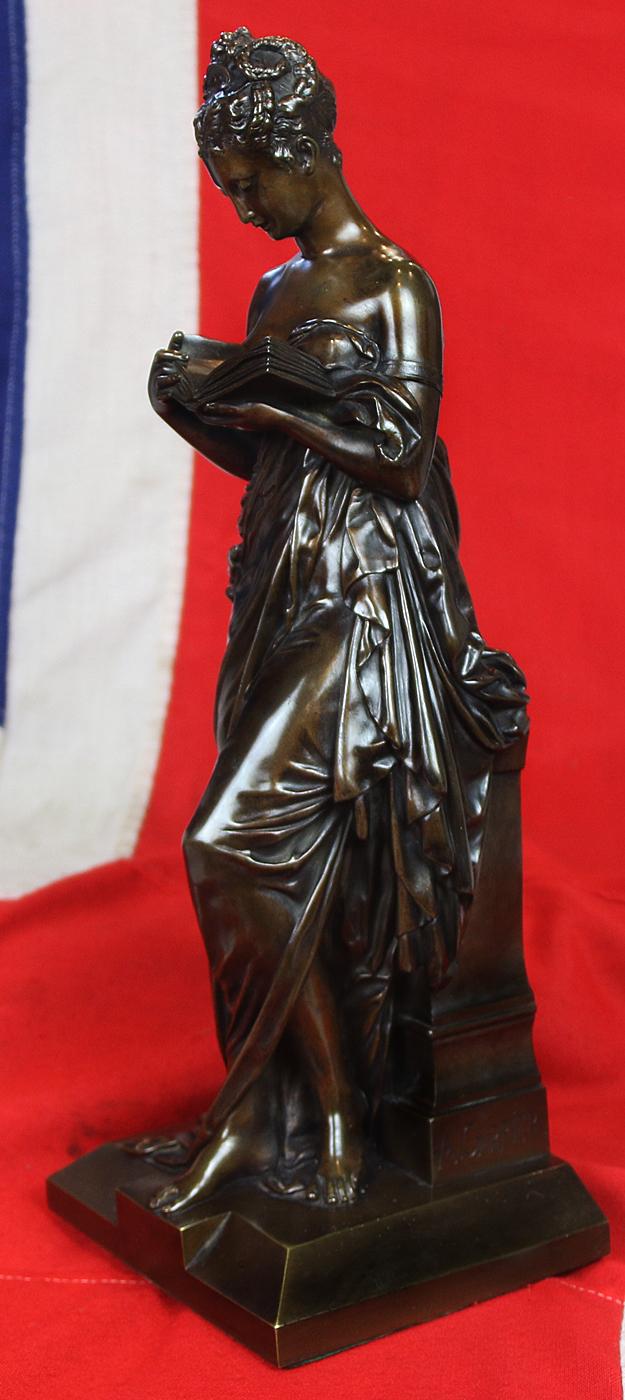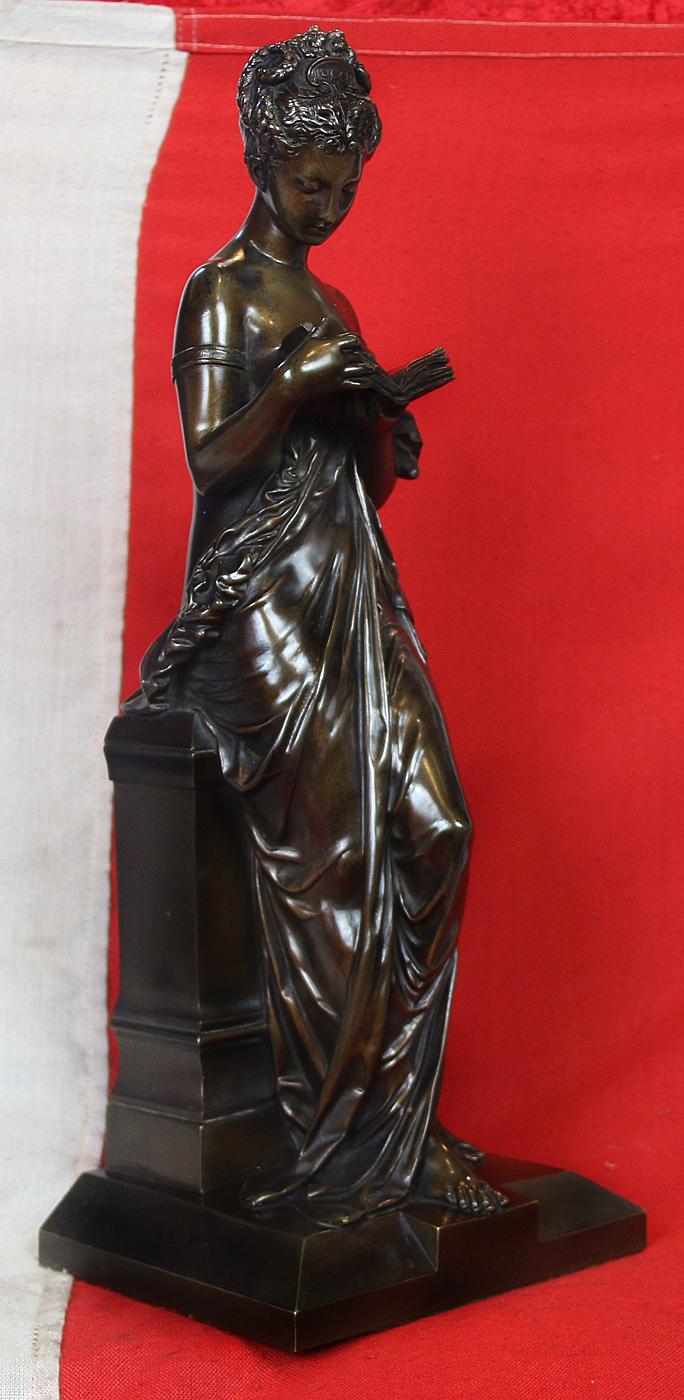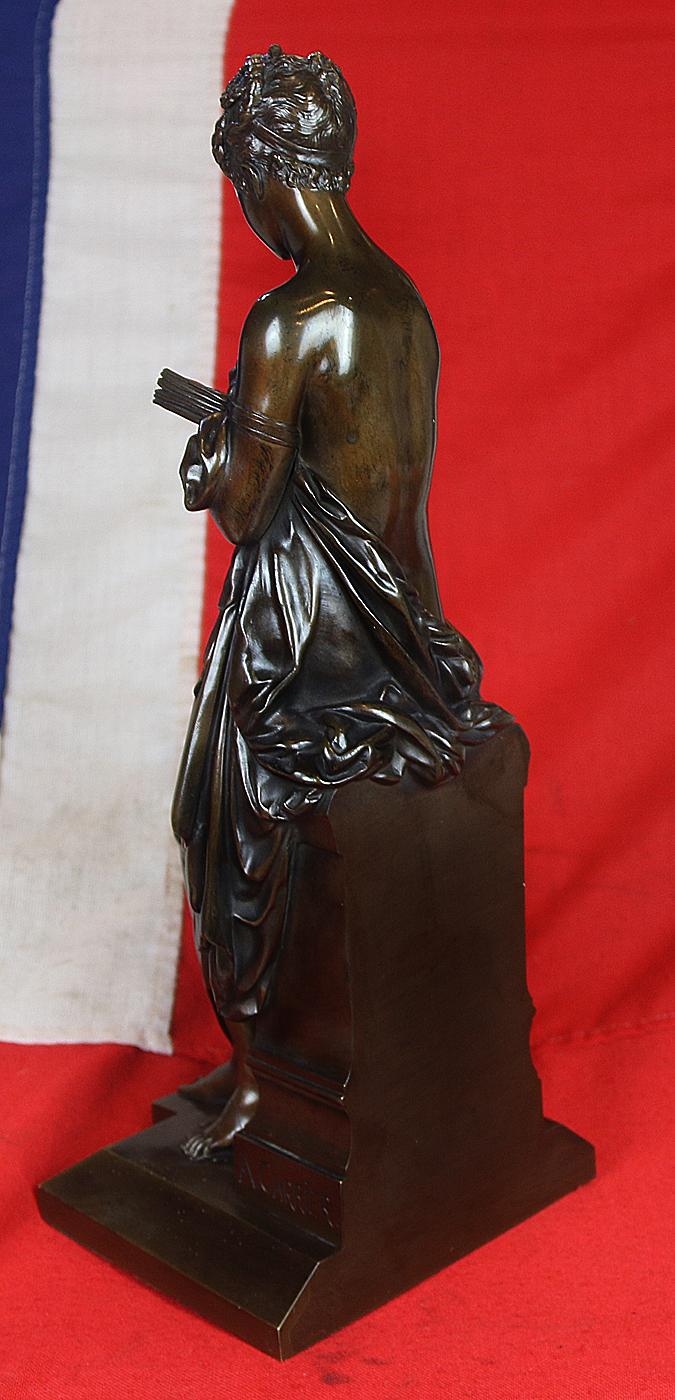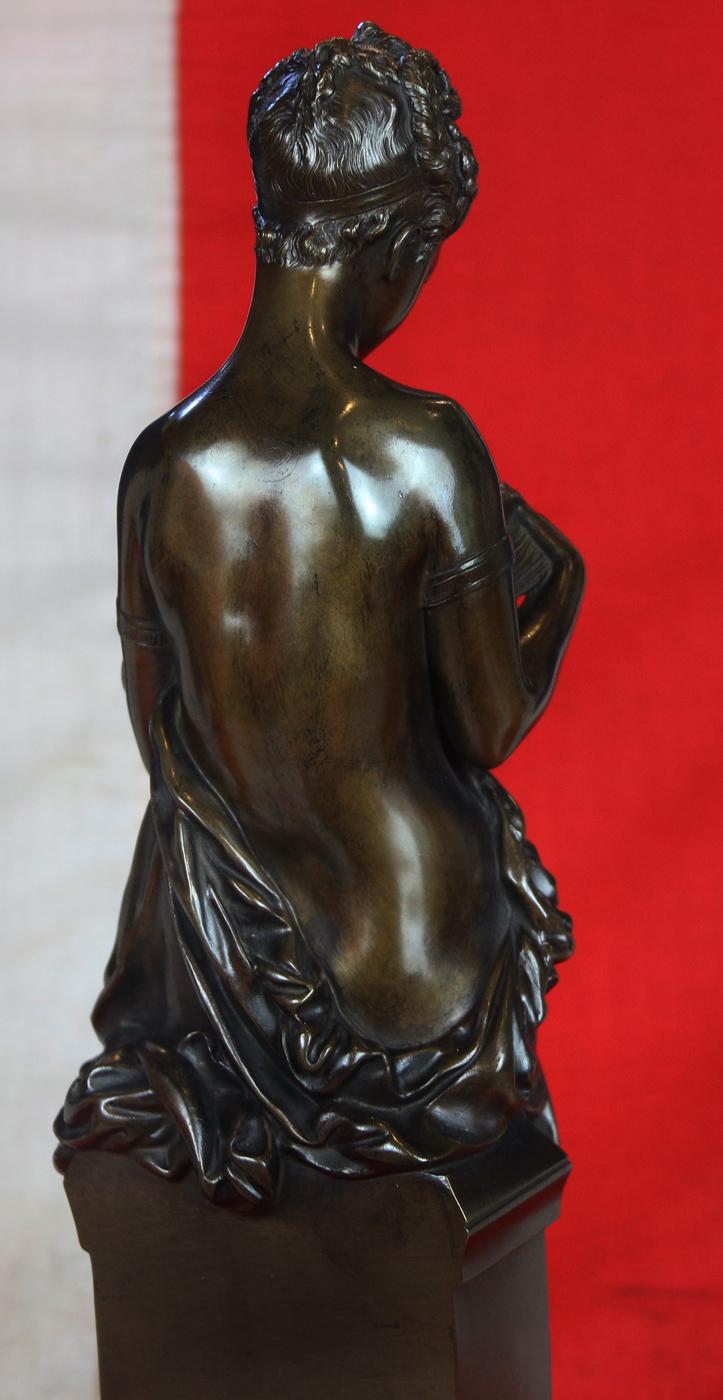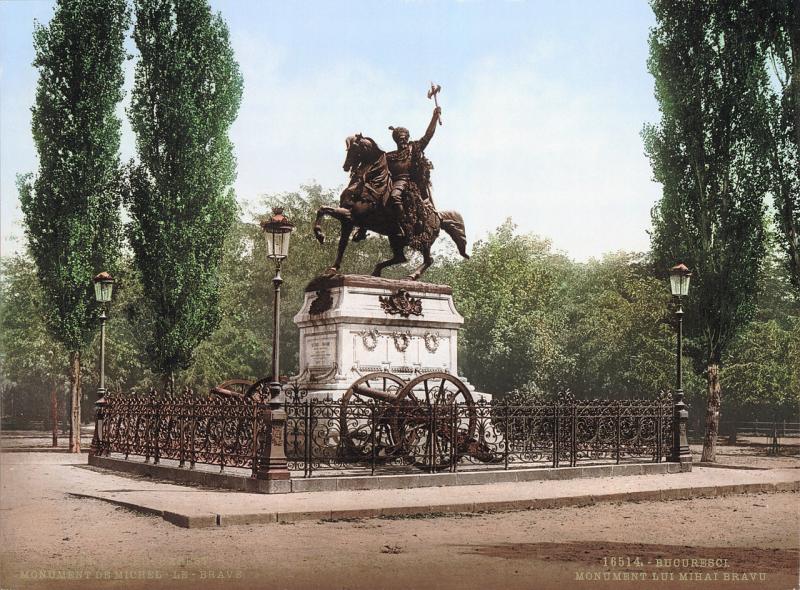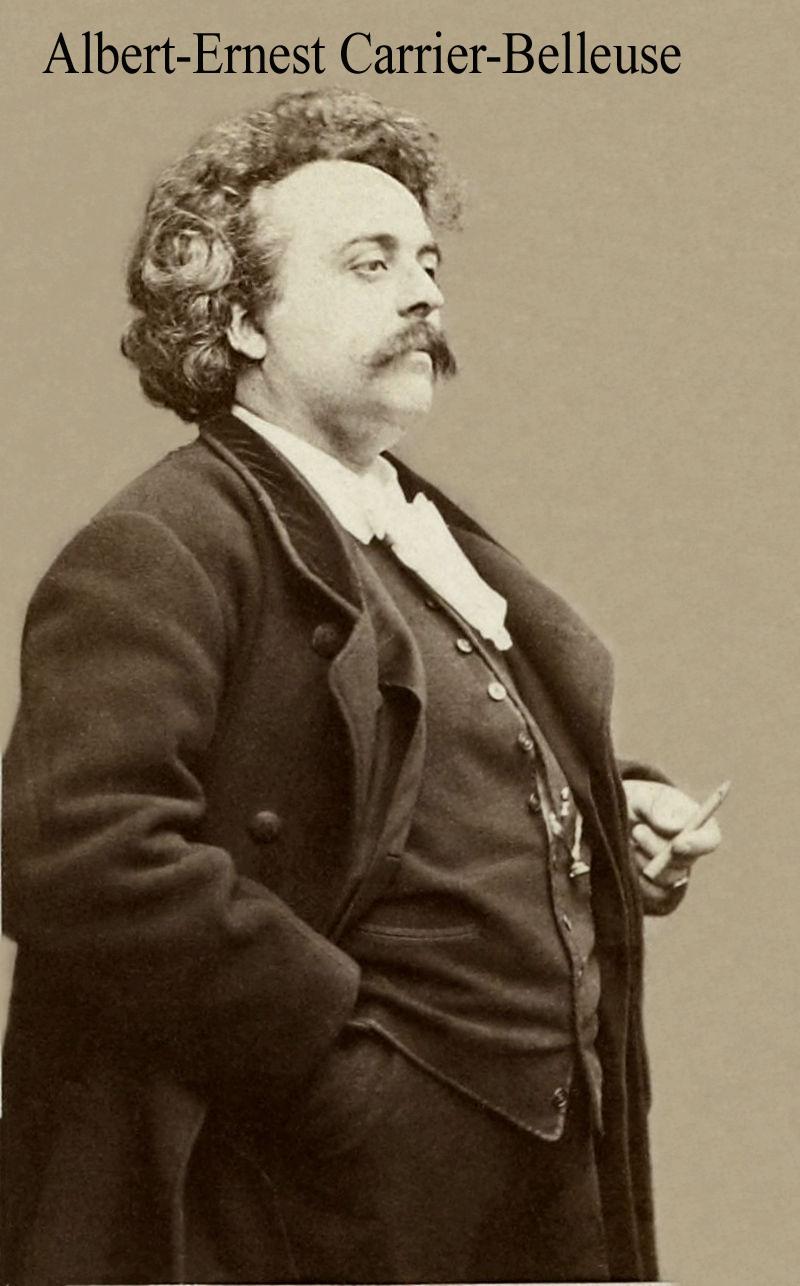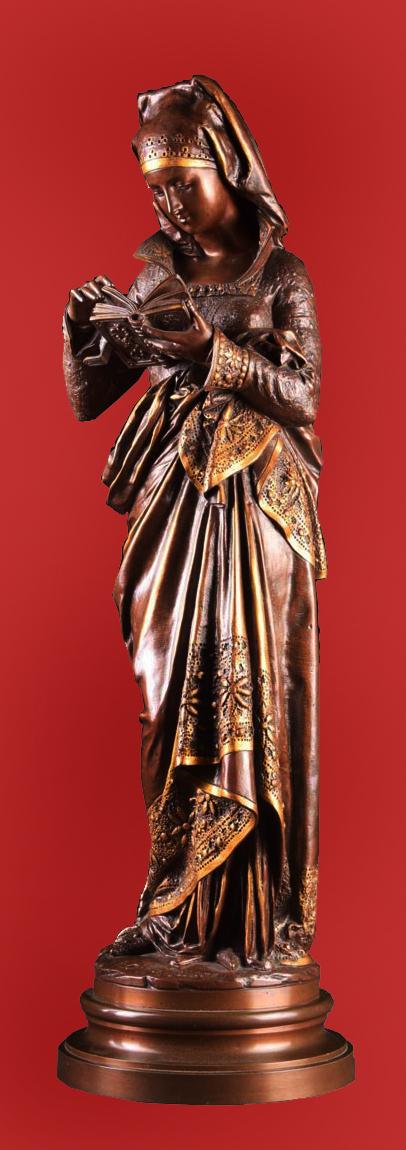An Absolutely Stunning Napoleon IIIrd, French Bronze. The Woman Reading, ‘La Liseuse’ by World Renown Sculptor, Albert-Ernest Carrier-Belleuse, Mentor to His Apprentice Auguste Rodin Who Became One of The Worlds Most Famous and Valued Sculptors
One of three versions he sculpted titled 'the Reader' by Carrier-Belleuse, and the rarest. One other, was the same model but she was wearing full Renaissance dress, including head-covering, another, of the same model was a woman reading with two small companions, and this scuplture, the erotic version, was of his favourite female model of a woman in a classical robe, semi naked reading a small book.
Albert-Ernest Carrier de Belleuse as known as Carrier-Belleuse (1824 - 1887) is one of the the most famous sculptors of the Second Empire, who touched all areas of sculpture, from porcelain of Sevres to monumental sculpture of marble, by way of a production of terracotta and bronze statuettes. He also trained one of the worlds greatest sculptors Auguste Rodin, who impressed his mentor to such a degree they even later collaborated on sculptures together.
Until 1872 Rodin's principal employer was Albert Ernest Carrier-Belleuse, the renowned decorative sculptor whose work cites those of the 18th century Rococo master Clodion. Rodin conceived of L'innocence tourmentée par l'amour, and, per his agreement with his teacher, Carrier-Belleuse signed the younger artist's works that were made at his studio. Rodin revisited this theme of cupids encouraging the sexual flourishing of a young woman in his later works, such as in Toilette de Vénus. Compagnie des Bronzes de Bruxelles produced editions of L'innocence tourmentée par l'amour for Carrier-Belleuse in terracotta, marble, biscuit de Sèvres and bronze until 1910.
Rodin created what is said to be the world's most famous sculpture. 'The Kiss' for Boston Millionaire E.P. WARREN, for £1,000 in around 1900 and it was delivered in 1904, and it lived in Warren House in Lewes East Sussex, then Lewes Town Hall in 1914. Then to a stable block in 1917, due to its unacceptable erotic nature, It lived in Lewes for a total of around 30 years.
12 years ago a pair of bronzes by Carrier-Belleuse, of the same age, quality and styl, titled, Spring and Summer, 2 works of gilt and patinated bronze and onyx circa 1850-1875, height 35.4 inches. They were sold at Christie's London April 29, 2010 lot 100 for $366,529.
Beginning at the age of thirteen at chiseler Beauchery’s workshop, Carrier-Belleuse learned from different goldsmiths, and was marked by the importance of the decorative arts. He worked quickly with Ferdinand Barbedienne and Deniere, the greatest bronze craftsmen of the century, in the realization of decorative objects, such as candelabra and fireplace garniture.
Fatherless orphan and protege of the Arago family, he obtained an official commission in 1848, a statue of the muse Rachel in gilded plaster. In 1863, his Bacchant in marble shown at the Salon is bought by Napoleon III, confirming his importance in the Second Empire. It was placed in the garden of the Tuileries from 1872 until 1984. He hence made the decoration of several prestigious buildings, in the Louvre, the Theatre of the Renaissance, on the pediment of the Bank of France, or at the Opera House of Palais Garnier, of which he supplied the two torches of the grand staircase.
As early as 1855, Carrier-Belleuse opened a workshop at the rue de la Tour d'Auvergne, 15, which welcomed many pupils, including Jospeh Cheret, Jules Dalou, and especially the great Auguste Rodin, who greatly benefited from this apprenticeship, and made his portrait in bust.
Carrier-Belleuse was probably best known for his production of statuettes and busts, as he realized many portraits of the personalities of his time, such as Theophile Gautier, Honore Daumier and Eugene Delacroix. He also sculpts portraits of some official figures with several busts of Napoleon III, and an important statue of the Countess of Castiglione. On the day following the ball of the 9th of February 1863 at the Tuileries, she wanted to make a portrait of her in her costume of Queen of Etruria, in a dignified pose, in order to counteract the slanders she had been the target of.
Carrier-Belleuse is also a great admirer of the Renaissance and the 18th century, from which he sculpts portraits of Shakespeare or Jean-Jacques Rousseau. He is inspired in his works by Renaissance art, especially the art from Fontainebleau. But he is also often considered as a new Clodion, 18th century sculptor of terracotta statuettes, for many gallant subjects and elegant busts of young women, such as the Bust of a young woman wearing a diadem, preserved in the Orsay Museum.
Thus, the monumental mirror exhibited by Barbedienne at the World’s Fair of 1867 , the true centerpiece of the stand, which emphasizes the pre-eminence of French skills in ornamental bronze, is decorated with characters by Carrier-Belleuse, in a Benvenuto Cellini manner.
Being one of the founding members of the Central Union of Fine Arts applied to Industry, now the Decorative Arts, his work is in keeping with the motto of this institute: "Beautiful in Useful". At the end of his career, he became art director of the Manufacture de Sevres, where he invented many designs with small sculptures, such as the Buire de Blois, at which Rodin worked. Finally, at the end of his life, a collection of drawings by Carrier-Belleuse was published, showing his involvement in the diffusion of beauty by the objects of everyday life: Application of the human figure to industrial decoration and ornamentation, 1884.
The son of Albert-Ernest Carrier-Belleuse, Louis-Robert Carrier-Belleuse, also became a renowned artist of decorative arts. Trained as a painter, and also a sculptor like his father, he mainly worked in ceramics, becoming art director of the Choisy
Famed works of art he created;
Monument to André Masséna
Nice, 1869
Hebe asleep, 1869
Paris, Musée d'Orsay
Pediment sculpture of Abundance, Pavillon de Flore, South façade of the Great Galerie, Louvre palace, Paris, circa 1863
Caryatids themed on the four seasons, Vichy Opera, for architect Charles Badger, 1865
Architectural sculpture for the Tribunal de commerce de Paris (Commercial Court of Paris), on the Île de la Cité, for architect Antoine-Nicolas Bailly, completed 1865
A silvered bronze chimney-piece for the Hôtel de la Païva, Paris, 1866
Monument to André Masséna, Nice, 1869
Architectural work at the Brussels Stock Exchange, Brussels, circa 1870
Mary Queen of Scots, Private Collection, ca. 1870
Two elaborate multifigure torchères for the base of grand staircase, Palais Garnier (Paris Opera), Pairs, 1873
Tomb of Belgian photographer Louis Ghémar, Laeken Cemetery, Brussels, 1873
Architectural work for the Théâtre de la Renaissance, Paris, for architect Charles de Lalande, 1873
Sea Nymph for the fountain at the Place du Theâtre-Français, Paris, for architect Gabriel Davioud, 1874
Bust of Aimée-Olympe Desclée for her tomb, 1874
Four Seasons fountain, Hotel de Ville, Fleurance
Mausoleum of José de San Martín, Buenos Aires Metropolitan Cathedral, Buenos Aires
Equestrian statue of Mihai Viteazul, University Square, Bucharest, Romania
Equestrian statue of Manuel Belgrano, Plaza de Mayo Square, Buenos Aires, Argentina
Equestrian statue of Bernardo O'Higgins, Alameda, Santiago de Chile, Chile
Statue for the victims of the La Compañía fire, originally at the place of the fire, today in front of the General Cemetery in Santiago de Chile, Chile
41cm height x 13cm depth x 15cm width
The much less rare 'fully clothed' version of The Woman Reading is shown in photo 10 in the gallery
Code: 24454
4950.00 GBP


